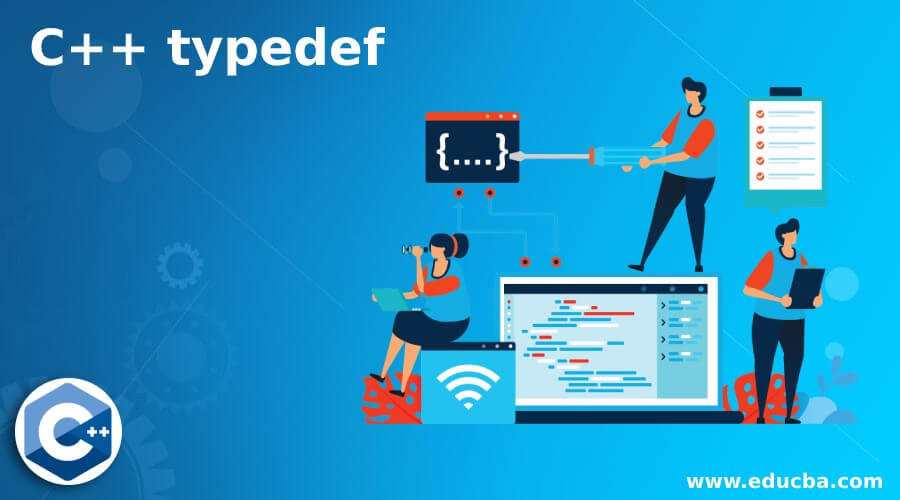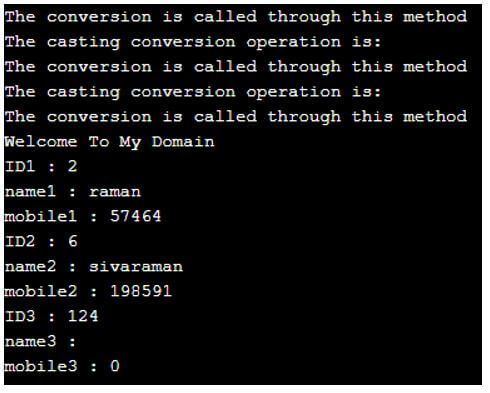Updated April 3, 2023

Introduction to C++ typedef
The following article provides an outline for C++ typedef. The typedef is one of the keywords it allows the developers to use for to create the new additional names for the default data types like int, float, long, short etc. It creates only the data types but does not create any additional types of values. When we use the typedef keyword, it returns the values the user must also be known if we want to change anything in the code, easily drag the definitions and to give the clarity about the old codes as well as new change codes, but we will highlight the codes using underlying options for the data types.
Syntax:
In C++ each object, variables and keywords have their own syntax and attributes for declaring in the programming codes. Based on the requirement, we will utilize the special keywords or reserved keywords from the programming library.
#include <iostream>
datatype main()
{
typedef old datatype name new datatype name;
typedef struct structure name;
{
datatype initialization;
}
---coding logics---
}The above codes are the basic syntax for using the typedef keywords in the programming logic. We can use the typedef as the structure using struct keyword type; by using this type, we can create n number of data types declaration as well as change the name in a single process.
How does typedef work in C++?
- Generally, the typedef is one of the reserved keywords; it provides the same level of abstractions from the actual data type and changes data types that are being used for programmers to allow it with the more focus on the coding concepts. It also makes it easier to write the programming codes and clean them using some destroy() or any other default methods because garbage collectors are the main area for destroying the unwanted codes and clean it for the memory space areas. Depending on the data types, the sizes must be calculated, and it allocates the memory space for the big storage data type variables and small amount storage variables.
- Normally the typedef declarations are used with the two different types like typedef type-declaration and typedef type-definition identifier; these two standard typedef declarations are covered with the new name types alias with the some syntax declarations for the language identifiers, and the other type is covered with the some standard libraries and in other POSIX specifications are included with the typedef definitions, and it is more often in the both prefix and suffix, and it includes the common sizes with more number of time calculations included in the codes. Moreover, a typedef keyword often used with the some documentations while indicating the number of the specific variable via included in the programming contexts that may include in the expressions with a variable number of unit measures with counts.
- The keyword also used to simplified the variable declarations for the some compound types like struct, union etc. or even though we included some pointers type in the syntax while we used pointer in the typedef keyword, it creates the specific memory storage in the compiler and as well as the address of the variable also changed in the both old and new data types. We can also use structure pointers in the typedef keyword that contains multiple variables with the same type and to declare with the single level statements even though the pointers are included or not in the structure type. The functional pointers also specified with the typedef the preceding number of coding lines will be rewritten with the typedef keyword it reduces the length and complexity of the programs. The functional declarations will be more cryptic, and it clearly shows with the accepts of arguments or the types, it will return the variables.
Examples of C++ typedef
Given below are the examples of C++ typedef:
Example #1
Code:
#include <iostream>
#include <string>
#include <cstring>
using namespace std;
typedef struct example
{
int id;
char name[14];
int mobile;
}s;
class demo {
int a;
public:
demo(int a_i = 1)
: a{a_i }
{
cout << "The conversion is called through this method" << endl;
}
operator string()
{
cout << "The casting conversion operation is:" << endl;
return to_string(a);
}
};
int main()
{
s j, k, l;
demo b(4)
string s = b;
b = 32;
string s1 = static_cast<string>(b);
b = static_cast<demo>(34);
j.id = 2;
strcpy(j.name,"siva");
j.mobile = 82202;
k.id = 4;
strcpy(j.name,"raman");
j.mobile = 57464;
k.id = 6;
strcpy(k.name,"sivaraman");
k.mobile = 198591;
cout << "Welcome To My Domain" << endl;
cout << "ID1 : " << j.id << endl;
cout << "name1 : " << j.name << endl;
cout << "mobile1 : " << j.mobile << endl;
cout << "ID2 : " << k.id << endl;
cout << "name2 : " << k.name << endl;
cout << "mobile2 : " << k.mobile << endl;
cout << "ID3 : " << l.id << endl;
cout << "name3 : " << l.name << endl;
cout << "mobile3 : " << l.mobile << endl;
return 0;
}Output:
Example #2
Code:
#include <iostream>
int main(){
typedef unsigned int a;
a p = 3, q = 5;
std::cout << "p = " << p << std::endl;
std::cout << "q = " << q << std::endl;
return 1;
}Output:
Example #3
Code:
#include<iostream>
using namespace std;
struct example
{
char *domain;
int id;
};
typedef int *pr;
int main()
{
struct example eg;
eg.domain = "Welcome To My Domain";
eg.id = 7879;
cout << "Have a Nice day user for chhosing the domain: " << eg.domain << '\n';
cout << "Your User id is: " << eg.id;
pr pvar;
return 0;
}Output:
In the above three examples, we used typedef in the different categories using the pointer concepts and the variables that have addressed the old and new ones.
Conclusion
In typedef is the specific reserved keyword area of the C++. It has a lot of pre-defined keywords used to implement the programming logic in the application. Here we used this keyword to mostly reduce the lines of codes and the memory areas also; we can use and edit the codes very clearly, so underlying the codes, it’s the must one for this keyword.
Recommended Articles
This is a guide to C++ typedef. Here we discuss the introduction, how typedef work in C++? Along with examples, respectively. You may also have a look at the following articles to learn more –




